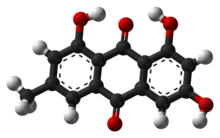Emodin (6-methyl-1,3,8-trihydroxyanthraquinone) is an organic compound. Classified as an anthraquinone,it can be isolated from rhubarb, buckthorn, and Japanese knotweed (Reynoutria japonica syn. Polygonum cuspidatum).[1] Emodin is particularly abundant in the roots of the Chinese rhubarb (Rheum palmatum), knotweed and knotgrass (Polygonum cuspidatum and Polygonum multiflorum) as well as Hawaii ‘au‘auko‘i cassia seeds or coffee weed (Semen cassia).[2] It is specifically isolated from Rheum palmatum L.[3] It is also produced by many species of fungi, including members of the genera Aspergillus, Pyrenochaeta, and Pestalotiopsis, inter alia. The common name is derived from Rheum emodi, a taxonomic synonym of Rheum australe, (Himalayan rhubarb) and synonyms include emodol, frangula emodin, rheum emodin, 3-methyl-1,6,8-trihydroxyanthraquinone, Schüttgelb (Schuttgelb), and Persian Berry Lake.[4]
Quick Facts Names, Identifiers ...
Emodin
 |
 |
| Names |
Preferred IUPAC name
1,3,8-Trihydroxy-6-methylanthracene-9,10-dione |
| Other names
6-Methyl-1,3,8-trihydroxyanthraquinone |
| Identifiers |
|
|
|
|
| ChEBI |
|
| ChEMBL |
|
| ChemSpider |
|
| DrugBank |
|
| ECHA InfoCard |
100.007.509  |
| KEGG |
|
|
|
| UNII |
|
|
|
InChI=1S/C15H10O5/c1-6-2-8-12(10(17)3-6)15(20)13-9(14(8)19)4-7(16)5-11(13)18/h2-5,16-18H,1H3  Y YKey: RHMXXJGYXNZAPX-UHFFFAOYSA-N  Y YInChI=1/C15H10O5/c1-6-2-8-12(10(17)3-6)15(20)13-9(14(8)19)4-7(16)5-11(13)18/h2-5,16-18H,1H3 Key: RHMXXJGYXNZAPX-UHFFFAOYAD
|
O=C2c1cc(cc(O)c1C(=O)c3c2cc(O)cc3O)C
|
| Properties |
|
C15H10O5 |
| Molar mass |
270.240 g·mol−1 |
| Appearance |
Orange solid |
| Density |
1.583±0.06 g/cm3 |
| Melting point |
256 to 257 °C (493 to 495 °F; 529 to 530 K) |
Except where otherwise noted, data are given for materials in their standard state (at 25 °C [77 °F], 100 kPa). |
Close
Emodin is an active component of several plants used in traditional Chinese medicine (TCM) such as Rheum palmatum, Polygonum cuspidatum, and Polygonum multiflorum. It has various actions including laxative, antibacterial and antiinflammatory effects,[5][6] and has also been identified as having potential antiviral activity against coronaviruses such as SARS-CoV-2,[7][8] being one of the major active components of the antiviral TCM formulation Lianhua Qingwen.[9][10]
Emodin has been shown to inhibit the ion channel of protein 3a, which could play a role in the release of the virus from infected cells.[11]
The following plant species are known to produce emodin:
Emodin also occurs in variable amounts in members of the crustose lichen genus Catenarina.[28]
Wang CH, Zhong Y, Zhang Y, Liu JP, Wang YF, Jia WN, et al. (February 2016). "A network analysis of the Chinese medicine Lianhua-Qingwen formula to identify its main effective components". Molecular BioSystems. 12 (2): 606–13. doi:10.1039/c5mb00448a. PMID 26687282. Wang XL, Yu KB, Peng SL (June 2008). "[Chemical constituents of aerial part of Acalypha australis]" [Chemical Constituents of Aerial Part of Acalypha australis]. Zhongguo Zhong Yao Za Zhi = Zhongguo Zhongyao Zazhi = China Journal of Chinese Materia Medica (in Chinese). 33 (12): 1415–7. PMID 18837345. Yadav JP, Arya V, Yadav S, Panghal M, Kumar S, Dhankhar S (June 2010). "Cassia occidentalis L.: a review on its ethnobotany, phytochemical and pharmacological profile". Fitoterapia. 81 (4): 223–30. doi:10.1016/j.fitote.2009.09.008. PMID 19796670. Nsonde Ntandou GF, Banzouzi JT, Mbatchi B, Elion-Itou RD, Etou-Ossibi AW, Ramos S, et al. (January 2010). "Analgesic and anti-inflammatory effects of Cassia siamea Lam. stem bark extracts". Journal of Ethnopharmacology. 127 (1): 108–11. doi:10.1016/j.jep.2009.09.040. PMID 19799981. Wang G, Wang GK, Liu JS, Yu B, Wang F, Liu JK (April 2010). "[Studies on the chemical constituents of Kalimeris indica]" [Studies on the Chemical Constituents of Kalimeris indica]. Zhong Yao Cai = Zhongyaocai = Journal of Chinese Medicinal Materials (in Chinese). 33 (4): 551–4. PMID 20845783. Ban SH, Kwon YR, Pandit S, Lee YS, Yi HK, Jeon JG (January 2010). "Effects of a bio-assay guided fraction from Polygonum cuspidatum root on the viability, acid production and glucosyltranferase of mutans streptococci". Fitoterapia. 81 (1): 30–4. doi:10.1016/j.fitote.2009.06.019. PMID 19616082. Gautam R, Karkhile KV, Bhutani KK, Jachak SM (October 2010). "Anti-inflammatory, cyclooxygenase (COX)-2, COX-1 inhibitory, and free radical scavenging effects of Rumex nepalensis". Planta Medica. 76 (14): 1564–9. doi:10.1055/s-0030-1249779. PMID 20379952. S2CID 260253513. Yang YC, Lim MY, Lee HS (December 2003). "Emodin isolated from Cassia obtusifolia (Leguminosae) seed shows larvicidal activity against three mosquito species". Journal of Agricultural and Food Chemistry. 51 (26): 7629–31. doi:10.1021/jf034727t. PMID 14664519. Kusari S, Zühlke S, Kosuth J, Cellárová E, Spiteller M (October 2009). "Light-independent metabolomics of endophytic Thielavia subthermophila provides insight into microbial hypericin biosynthesis". Journal of Natural Products. 72 (10): 1825–35. doi:10.1021/np9002977. PMID 19746917. Søchting U, Søgaard MZ, Elix JA, Arup U, Elvebakk A, sancho LG (2014). "Catenarina (Teloschistaceae, Ascomycota), a new Southern Hemisphere genus with 7-chlorocatenarin". The Lichenologist. 46 (2): 175–187. doi:10.1017/s002428291300087x. S2CID 83906534. The British Pharmacopoeia Secretariat (2009). "Index, BP 2009" (PDF). Archived from the original (PDF) on 11 April 2009. Retrieved 20 April 2010.

